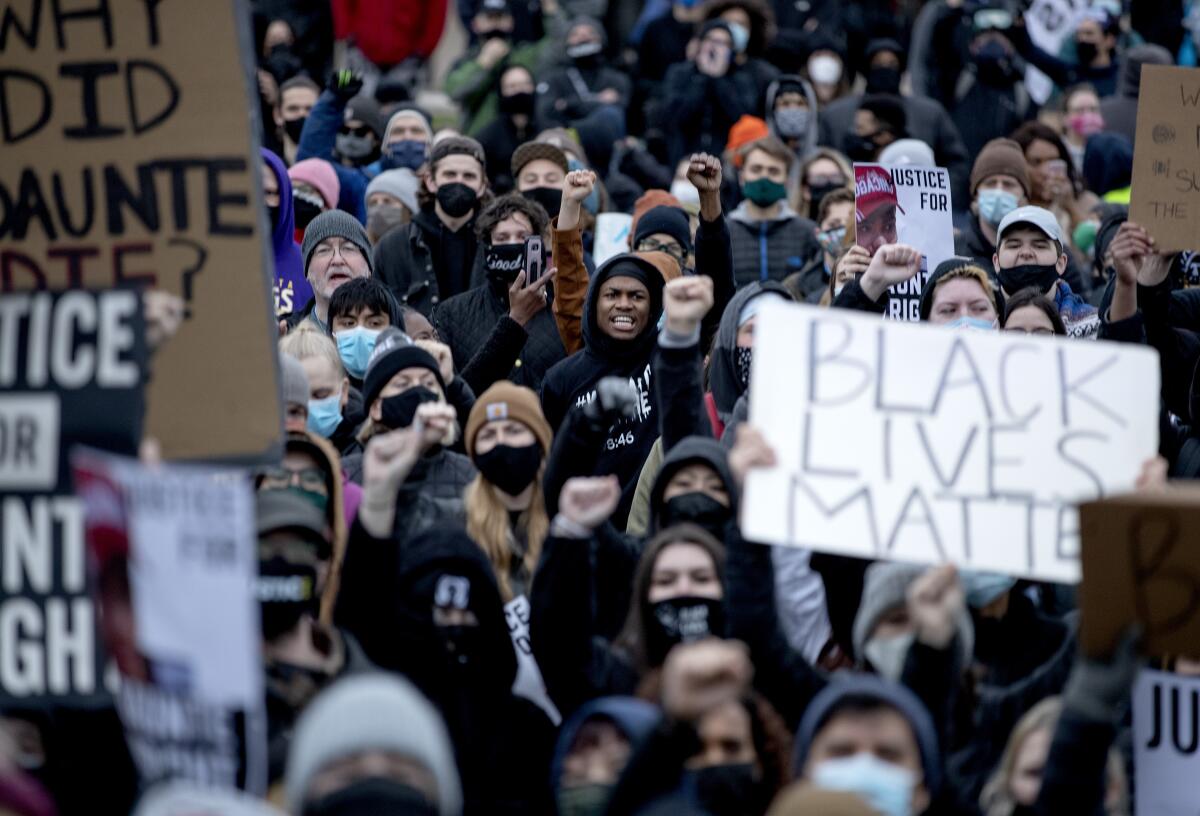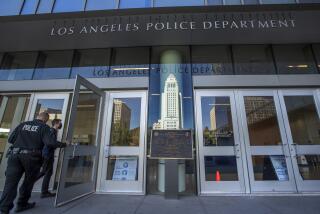Confusing a gun with a Taser has happened before, but it’s rare

- Share via
A suburban Minneapolis police officer who fatally shot a Black man during a weekend traffic stop accidentally drew her firearm instead of a stun gun, the city’s police chief said Monday. Although rare, similar incidents have happened in recent years across the U.S.
Brooklyn Center Police Chief Tim Gannon said the officer — later identified as Kim Potter, a 26-year veteran who has been placed on administrative leave — had made a mistake in firing her gun at 20-year-old Daunte Wright, who later died. Video of the shooting taken from the officer’s body camera includes audio of her uttering an expletive and saying, “I shot him,” after firing a single round from her handgun.
Gannon said the officer’s immediate distress showed that her use of the gun was unintentional.
“As you can hear, the officer, while struggling with Mr. Wright, yells: ‘Taser! Taser!’ several times. That is part of the officer’s training prior to deploying a Taser, which is a less lethal device,” Gannon said. “As I watch the video and listen to the officer’s commands, it is my belief that the officer had the intention to deploy their Taser, but instead shot Mr. Wright with a single bullet.”
Some questions and answers about officers who mistakenly discharge firearms when they intended to draw and deploy stun guns:
How frequently does this happen?
Experts agree this is a real but very rare occurrence that probably happens less than once a year nationwide. A 2012 article published in the monthly law journal of Americans for Effective Law Enforcement documented nine cases dating back to 2001 in which officers shot suspects with handguns when they said they meant to fire stun guns.
Why does it happen?
Reasons cited include officer training, the way they carry their weapons and the pressure of dangerous, chaotic situations. To avoid confusion, officers typically carry their stun guns on their weak side — the side of their non-dominant hand — and away from handguns that are carried on the side of their stronger arm. This is the case in Brooklyn Center, where Gannon, the police chief, said officers are trained to carry a handgun on their dominant side and their stun gun on their weak side.
Bill Lewinski, an expert on police psychology and founder of the Force Science Institute in Mankato, Minn., has described mix-ups as “slip and capture” errors. Lewinski, who has testified on behalf of police, has said officers sometimes perform the direct opposite of their intended actions under stress — their actions “slip” and are “captured” by a stronger response. He notes that officers train far more often on drawing and firing their handguns than they do on their stun guns.
As two Los Angeles police officers wrestled with a vandalism suspect, one grabbed her Taser and pressed the stun gun against the 38-year-old man’s body.
Other experts express skepticism about the theory.
“There’s no science behind it,” said Geoffrey Alpert, a criminology professor at the University of South Carolina and an expert on police use of force. “It’s a good theory, but we have no idea if it’s accurate.”
Alpert said a major factor in why officers mistakenly draw their firearm is that stun guns typically look and feel like firearms. Mayor Melvin Carter of St. Paul, Minn., brought up the same point during a news conference Monday.
“Why do we even have Tasers that operate and function and feel and deploy exactly like a firearm?” Carter asked. “Why can’t we have Tasers that look and feel different? That you could never mistake for deploying a firearm so that we can ensure that mistake that has happened before can never happen again?”
What are some other cases?
In one of the most well-known cases, a transit officer responding to a fight at a train station in Oakland killed 22-year-old Oscar Grant in 2009. The officer, Johannes Mehserle, testified at trial that, fearing Grant had a weapon, he reached for his stun gun but mistakenly pulled his .40-caliber handgun instead. Grant was shot as he lay face down.
The incident was the basis for the critically acclaimed film “Fruitvale Station.”
In ‘Fruitvale Station,’ parallels to Trayvon Martin
Mehserle was convicted of involuntary manslaughter and sentenced to two years in prison. His department paid $2.8 million to Grant’s daughter and her mother.
In Tulsa, Okla., a white volunteer sheriff’s deputy, Robert Bates, accidentally fired his handgun when he meant to deploy his stun gun on an unarmed Black man, Eric Harris, who was being held down by other officers in 2015. Bates apologized for killing Harris but described his deadly mistake as a common problem in law enforcement, saying: “This has happened a number of times around the country. ... You must believe me, it can happen to anyone.”
Bates was convicted of second-degree manslaughter and sentenced to four years in prison. Tulsa County ultimately agreed to pay $6 million to Harris’ estate to settle a federal civil rights lawsuit.
In 2019, a suburban St. Louis police officer, Julia Crews, said she meant to use her stun gun but mistakenly grabbed her service revolver and shot a suspected shoplifter, Ashley Hall, who suffered serious injuries. Crews resigned and has pleaded not guilty to a pending charge of second-degree assault.
The city of Ladue, Mo., admitted no wrongdoing as part of a $2-million settlement with Hall.
More to Read
Sign up for Essential California
The most important California stories and recommendations in your inbox every morning.
You may occasionally receive promotional content from the Los Angeles Times.










